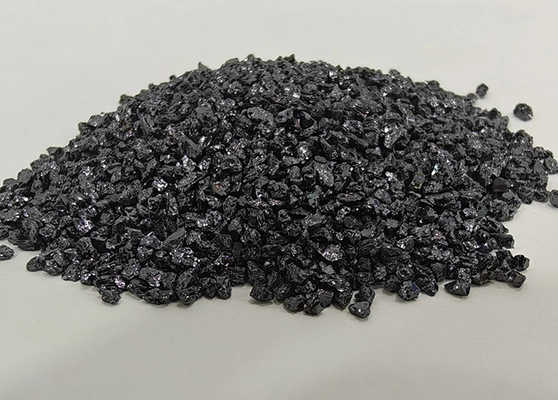Aluminum Oxide (Al₂O₃) in Abrasives: Properties, Applications & Selection
What Is Aluminum Oxide?
Aluminum oxide (aka alumina, formula Al₂O₃) is a ceramic oxide most commonly in the α-alumina (corundum) crystal phase. In abrasives you’ll mainly see:
- White Fused Alumina (WFA) – made from calcined alumina; high purity, low contaminants, sharp. Delivers cool cutting and clean finishes on stainless steel, non-ferrous metals, glass, and ceramics. (Internal link: White Fused Alumina)
- Brown Fused Alumina (BFA) – fused bauxite with small amounts of TiO₂/Fe₂O₃; tough, impact-resistant. Suited for heavy grinding, blasting, anti-skid, and refractory aggregate. (Internal link: Brown Fused Alumina)
Chemical Basics
- Formula: Al2O3 (also called alumina; most common phase: α-Al2O3, corundum)
- Molar mass: 101.96 g/mol
- Ionic view: 2Al3+ + 3O2− → Al2O3
- Balanced formation (from elements): 4Al + 3O2 → 2Al2O3
Key Properties (Cheat Sheet)
| Parameter | Typical Range / Note | Why It Matters |
|---|---|---|
| Chemical formula | Al₂O₃ | Core composition; drives hardness & heat resistance |
| Mohs hardness | ~9 | Works for most metals, wood, stones, & composites |
| Purity (WFA) | ≈ 99% Al₂O₃ | Clean cutting; low discoloration; stainless & glass finishing |
| Purity (BFA) | ≈ 94–97% Al₂O₃ | Higher toughness; value for heavy stock removal/blasting |
| Density (true) | ~3.9–4.1 g/cm³ | Impacts wheel strength, media mass, and blasting profile |
| Friability | WFA higher; BFA lower | WFA self-sharpens; BFA sustains load/impact longer |
| Standards | FEPA F/P, ANSI, JIS | Specify and lock sizing (PSD) for reproducible results |
WFA vs. BFA: What’s the Difference?
| Aspect | White Fused Alumina (WFA) | Brown Fused Alumina (BFA) |
|---|---|---|
| Cutting behavior | Sharp, cool, clean | Strong, durable, high impact |
| Best for | Stainless, non-ferrous, glass/ceramics, precision finishing | Carbon steel, castings, structural steel, blasting, anti-skid |
| Friability | Higher (self-sharpening) | Lower (longer life in heavy load) |
| Finish targets | Fine Ra, low burn | Robust removal, consistent profile |
| Cost position | Premium | Value/standard |
Typical Applications & Process Notes
- Bonded grinding wheels (vitrified/resin) – Control FEPA F grit, shape/elongation, and impurity limits (Fe₂O₃/TiO₂). Validate wheel speed & dressing response. WFA for stainless and precision; BFA for general steel removal.
- Coated abrasives (belts/discs/sheets) – Ensure tight PSD and grain treatment (if used) for adhesion. Balance cut rate vs. life for wood, aluminum, and steel lines.
- Blasting media – Prioritize cleanliness/low dust, recyclability, bulk density, and angularity. Match mesh to target profile (Ra/Rz) and coating spec.
- Anti-skid & wear surfaces – Require hardness, angular retention, and binder compatibility for long-term texture.
- Refractory aggregates – Check chemistry, bulk/true density, thermal shock resistance, and gradation curve for castables/shotcretes.
Selection Checklist
- Define the job: removal vs. finish target (cut rate, life, Ra/Rz, geometry).
- Lock the standard: FEPA/ANSI/JIS; specify grit and allowable oversize (Pmax or equivalent).
- Chemistry limits: Al₂O₃ target and max Fe₂O₃/TiO₂; note Na₂O/SiO₂ for refractories.
- Physicals: bulk/true density, toughness/friability, angularity, cleanliness (especially for blasting).
- Process fit: bond system, resin cure, firing cycle, blast recovery, machine power & guard dimensions.
- Quality proof: request COA, PSD curves, wheel speed/dress data, thermal shock results as relevant.
Compatibility: Bonds & Machines
- Vitrified bonds: need stable grain size & shape; WFA favored for precision/cool grind.
- Phenolic bonds: BFA suits heavy stock removal; WFA mixes improve finish on stainless.
- Coated systems: check make/size coat resin, backing stiffness, and grit treatment synergy.
- Machines: confirm surface speed (m/s), available power, guard clearance, and dressing method.
FAQ
Is aluminum oxide the same as alumina?
Yes—alumina is the common name for aluminum oxide, chemical formula Al₂O₃.
When should I choose WFA over BFA?
Choose WFA for high-purity, cool cutting and fine finishes (stainless, non-ferrous, glass/ceramics). Choose BFA for tougher grinding, blasting, and value-driven steel work.
Which standard should I specify—FEPA, ANSI, or JIS?
Any is fine—pick one and stay consistent. Include the PSD curve and oversize limit to ensure repeatability.
Does aluminum oxide contaminate stainless?
Use high-purity WFA and low-iron processes/fixtures to reduce risk of contamination and surface discoloration.
What mesh/grit for blasting a paintable profile?
Depend on coating spec; as a rule of thumb, select mesh to achieve the target Ra/Rz. Verify with trial coupons.
References & Standards
- FEPA grit standards (F/P series)
- ANSI/CAMI abrasive grain standards
- JIS abrasive grain standards
- Typical producer datasheets for WFA/BFA (chemical & PSD ranges)
